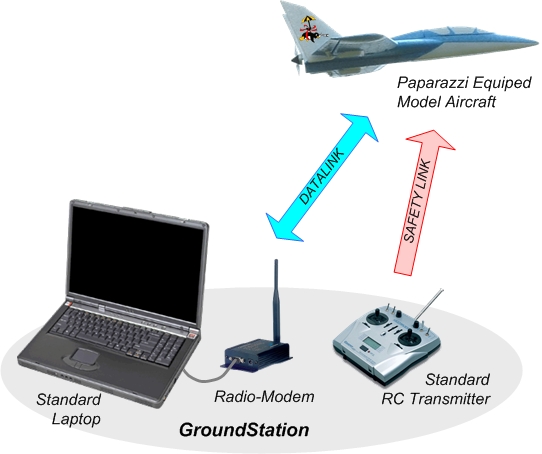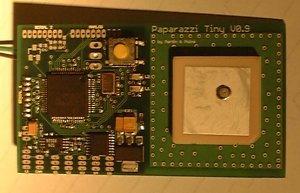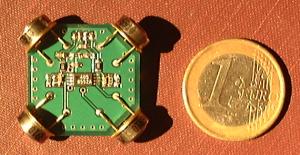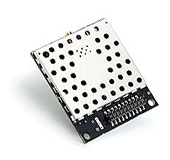Overview
Paparazzi is a complete system of hardware and software for autonomous aircraft as well as complete ground station mission planning and monitoring software utilizing a bi-directional datalink for telemetry and control.
Aircraft

|
|
The Airframe
The Paparazzi airborne system is highly configurable and can be used to fly autonomously almost any airframe. It has already been used for airframes ranging from 30cm to 1.4m, 1.4kg. In the early days of the project, only easy to fly airframes of the shelf were favoured. Today, the Paparazzi autopilot flies at least half a dozen of more or less customized aircraft.
The choice of the right airframe is constrained by many parameters (size, payload weight, easiness to build or to launch, cost, ...) but not by the autopilot itself.
Airborne Electronics
Controller Board
Several controller boards have been designed to run the Paparazzi autopilot software, using either Atmel AVR or Philips ARM7 LPC micro-controllers. These boards include one or two micro-controllers and the required connectors to handle the servos, motor controllers, sensors, RC receiver, radio modem, and a variety of payloads. All the schematics and PCBs files are available under the GPL licence. There are currently no vendors offering PCB kits or assembled controller boards.
More details on the controller boards are available on the Hardware Pages.
Sensors
Airborne hardware includes sensors like infrared, GPS & Gyroscope. A standard GPS receiver (from u-blox) is used, packages as a module or soldered on the board itself and Gyroscope and infrared sensors boards are easy to assemble.
More details on the sensors are available on the Hardware Pages.
Communications
Airborne hardware also includes communications devices : Radio Modem (Datalink) & RC Receiver (Safety Link). Any wireless device providing a serial link can be used for the telemetry and the telecontrol (Datalink).
More details on communications hardware are available on the Hardware Pages.
Airborne Software
The Paparazzi autopilot provides the following features:
- RC receiver (PPM signal) decoding
- Servos and motor controller (PPM signal) control
- Manual control with the RC
- Control with augmented stability (named AUTO1)
- Autonomous navigation (named AUTO2) in 3D, including
- Waypoint navigation
- Segment and circle navigation
- Altitude hold, glide following
- High level flight plan language execution (sequence, loops, goto, ...)
- Telemetry to the ground station
- Telecontrol (datalink) from the ground station (navigation control, waypoint modifications, tuning)
The autopilot code is written in C while all the configuration code is translated from XML files at compile time. Code is segregated into two processes respectively handling the fly by wire (manual control) and the autopilot itself (stabilization and navigation). These processes are segregated on two-processor controllers such as the Classix.
Ground Control Station (GCS)
Ground Computer
The software is developped to be run on a i386 architecture with the Debian GNU/linux operating system. However a Live CD including all the software is provided: it should be able to boot any standard laptop.
Ground Software
The software mainly provides
- compiling tools to produce the airborne code from the configuration;
- a GUI to control and interact with the UAV(s) during flight;
- a basic simulator to ease the development of flight plans.
Datalink
Paparazzi offers several possibilities to supervise the UAV flight from the ground. The default one uses a bidirectionnal wireless modem which supports both telemetry (downlink) and telecontrol (uplink). Thanks to this datalink, flight parameters are available in real time and full control of the navigation of one or several aircraft is possible on the ground station.
Safety Link
The airborne hardware and software support the connection to a standard (patched) radio-control receiver. While this link is not required for actual autonomous flights, it may help during the tuning of a new aircraft and is usually considered as an important safety control redundancy.
Payloads
Paparazzi has not been designed with a specific payload in mind. However the airborne control board offers several connectors to control extra servos (to point a [:Overview/PayloadUseCases#camera: video camera]), to connect digital devices (e.g. to switch on lights (for night flights) or trigger a digital camera) or to exploit a sensor with an ADC or a serial link. The associated required sofware can be easyly integrated in the autopilot open Paparazzi code. The Classix Paparazzi control board model can also be connected to a [:Overview/PayloadUseCases#gumstix: generic application board].
Disclaimers
It should be understood that smooth, reliable autonomous flight is a great feat and will require significant time and effort to achieve, even with a highly evolved open system like Paparazzi. The time required will vary based on experience, aircraft, and luck. From experience however, users can expect to spend a similar amount of time learning and configuring Paparazzi as they may with any of the commercially available systems.
Linux itself can pose quite a challenge to install, configure, and learn. To help ease the transition for those not already running Linux, the LiveCD option is available to help get you started. The LiveCD allows the user to save all configuration files as well as any user-modified source code on a pen drive or as a compressed file on your hard drive without affecting your existing OS. We strongly urge new users to Contact someone from the Paparazzi team before beginning any hardware invenstment as we can help you get the most out of the system.



